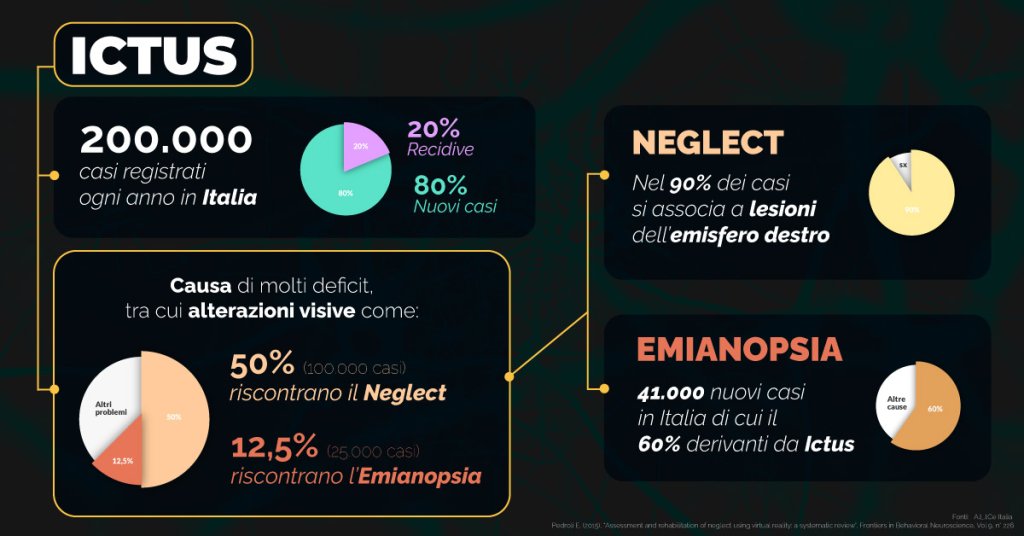Hemianopia
Hemianopia: symptoms, causes, and treatments
Hemianopia is a symptomatology known among experts in the field but still unfamiliar to the public. In Italy, 60% (about 25,000 each year) of hemianoptics undergo this symptomatology as result of a stroke and, considering the progressive increase in average life expectancy, the risk to see these numbers increase is ever more.
This symptomatology manifests itself as a consequence of injuries related to traumatic events, frequently resulting from vascular dementia in the primary visual cortexes, areas designated for the processing of visual information such as shape, position, and movement of objects within our visual field.

Want to learn about new treatments for Hemianopia?
What does Hemianopia mean?
This visual impairment gets its name from the Greek word hemianopia: (ημιανοψία):
- mi (ἡμι): “middle”
- an (ἀν) privative: “without”
- opsis (ὄψις): “view”
Hemianopia’s symptoms
Since only one of the two cerebral hemispheres has undergone damage, the deficit shown concerns only part of the visual field. Thus, he impossibility of perceiving only one half of the visual field is a result of an injury to one of the two occipital lobes.
What are the causes?
Here are the main causes from which this symptomatology arises:
- thrombosis
- ictus
- aneurisms
- compression of the optical pathways
- cerebral tumors
- cerebral ischemia
The major issue in these instances relate to the impairment of the normal dynamics of transmission of bioelectric signals, affecting the communication phase of this information in the passage between the retina and the visual cortex 1. If the cerebral area or a nerve fiber is subjected to an unnatural pressure, it prevents the correct flow of bioelectric impulses.
Optical chiasm: what is it and what is its incidence?
Lesions that damage the cerebral cortex may develop anteriorly, posteriorly, or at the same level as the optic chiasm ( which is defined as that area of the brain in which occurs a partial cross between the nerve fibers that go to constitute the optic nerves ).
The precise position in which the injury occurs is of fundamental importance, allowing us to distinguish three types of lesions 2:
- pre-chiasmatic: in this case the lesion manifests itself in the area anterior to the chiasm.
- chiasmatic: lesion that is in line with the chiasm.
- retro-chiasmatic: lesion located in the area behind the optic chiasm.
How is Hemianopia treated?
If said pressure is generated by a tumor of the pituitary gland or an aneurysm, we could turn to surgery:
- to surgically export adenoma in the first case
- vascular surgery in the second
If there is necrosis in the nerve cells belonging to the optic tract, surgery could represent the perfect answer.
Another type of treatment is represented by glasses equipped with hemianoptic lenses that allow the patient to get familiar with the space around him. However, the process of adaptation to these prismatic lenses takes a long time, and it is possible to experience disruptions or issues with said treatment course 3.
In the field of neurorehabilitation, we witnessed a real breakthrough when we turned to multisensory stimulation of intact subcortical structures, by taking advantage of brain plasticity.
What are the types of Hemianopia?
Before we begin we recommend a short video posted by the Santo Stefano Riabilitazione channel in which a brief presentation of this disorder is made.
We distinguish 4 different kinds of hemianopia 2:
- Bitemporal heteronima: due to a loss of temporal field of view. In this case the patient’s visual cone is limited to the central focus only, thus losing the perception of peripheral vision.
- Binasal heteronima: due to a loss of the nasal visual field. Extremely rare condition that goes to obscure the nasal visual field, thus generating two blind spots inward.
- Homonymous hemianopia (left and right): in this case, blind spots characterize the right or left area of the visual field. A lesion involving the right occipital lobe will generate a blind spot in the left visual field, and vice versa.
- Altitudinal: unlike the homonymous right and left, in which the blind spots were manifested by vertical sections, they now affect the horizontal planes: loss of sight affects the upper or lower half of the visual field; in the event of lesions being present exclusively on one side, we refer to it as quadrantopsia.
Diagnosis hypothesis: what differentiates Homonymous Hemianopia from the others
After a careful analysis of the type of visual field deficiency in which we have incurred it is possible to reach a diagnosis on the area in which the injury occurred 4:
- As for the homonym, we could hypothesize that the lesion is located on the optic pathway: from the optic tract (continuation of the optic nerve) to the visual cortex.
- If, on the other hand, the lesion simultaneously affects the fiber bundles corresponding to the lateral angles of the chiasm, we are in the presence of a binasal lesion.
- Instead, a bitemporal lesion occurs if said lesion affected the ( anterior or posterior ) angles of the optic chiasm.
Hemianopia, however, presents itself with an extremely complex symptomatology, independently from its classification, capable of enclosing and involving multiple functional areas.
References
- Emianopsia – Cause e Sintomi – ottobre 2019
- Emianopsia – Dott.ssa Giulia Bertelli – ottobre 2019
- Dalle sindromi alle malattie neurologiche: ricerca traslazionale, appropriatezza diagnostica e terapeutica. – Dott.ssa Laura Taddei – aprile 2018
- Emianopsia: sintomi, cura, temporanea, omonima, unilaterale, controlaterale – Dott. Emilio Alessio Loiacono – settembre 2018
Want to learn about new treatments for hemianopia?
You are free to reproduce this article but you must cite: emianopsia.com, title and link.
You may not use the material for commercial purposes or modify the article to create derivative works.
Read the full Creative Commons license terms at this page.

